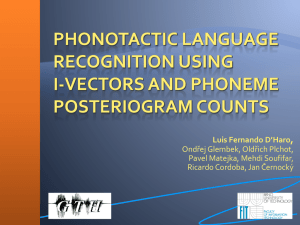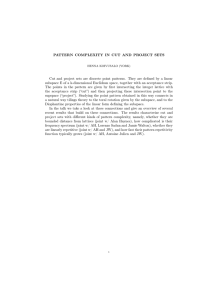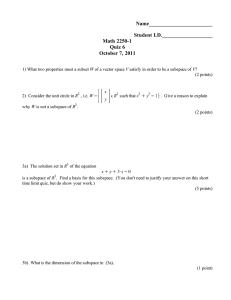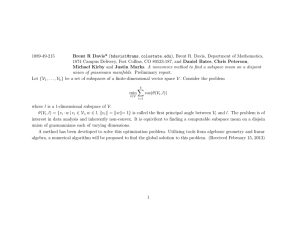soufifar_interspeech2013_IS13..
advertisement
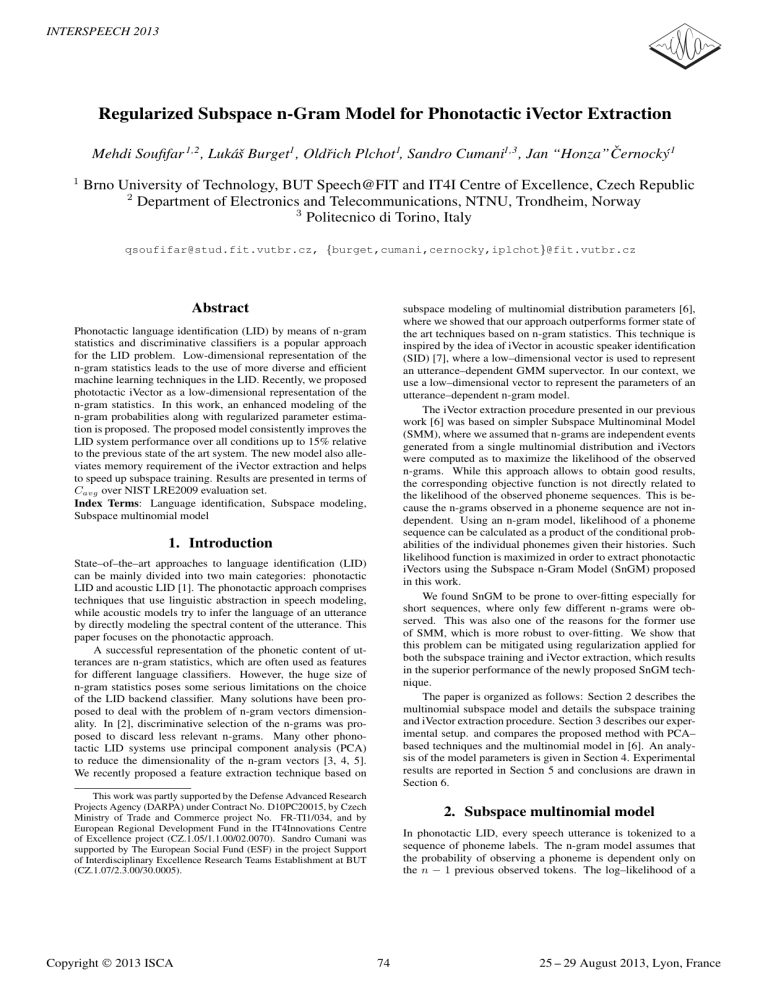
INTERSPEECH 2013
Regularized Subspace n-Gram Model for Phonotactic iVector Extraction
Mehdi Soufifar 1,2 , Lukáš Burget1 , Oldřich Plchot1, Sandro Cumani1,3 , Jan “Honza” Černocký 1
1
Brno University of Technology, BUT Speech@FIT and IT4I Centre of Excellence, Czech Republic
2
Department of Electronics and Telecommunications, NTNU, Trondheim, Norway
3
Politecnico di Torino, Italy
qsoufifar@stud.fit.vutbr.cz, {burget,cumani,cernocky,iplchot}@fit.vutbr.cz
Abstract
subspace modeling of multinomial distribution parameters [6],
where we showed that our approach outperforms former state of
the art techniques based on n-gram statistics. This technique is
inspired by the idea of iVector in acoustic speaker identification
(SID) [7], where a low–dimensional vector is used to represent
an utterance–dependent GMM supervector. In our context, we
use a low–dimensional vector to represent the parameters of an
utterance–dependent n-gram model.
The iVector extraction procedure presented in our previous
work [6] was based on simpler Subspace Multinominal Model
(SMM), where we assumed that n-grams are independent events
generated from a single multinomial distribution and iVectors
were computed as to maximize the likelihood of the observed
n-grams. While this approach allows to obtain good results,
the corresponding objective function is not directly related to
the likelihood of the observed phoneme sequences. This is because the n-grams observed in a phoneme sequence are not independent. Using an n-gram model, likelihood of a phoneme
sequence can be calculated as a product of the conditional probabilities of the individual phonemes given their histories. Such
likelihood function is maximized in order to extract phonotactic
iVectors using the Subspace n-Gram Model (SnGM) proposed
in this work.
We found SnGM to be prone to over-fitting especially for
short sequences, where only few different n-grams were observed. This was also one of the reasons for the former use
of SMM, which is more robust to over-fitting. We show that
this problem can be mitigated using regularization applied for
both the subspace training and iVector extraction, which results
in the superior performance of the newly proposed SnGM technique.
The paper is organized as follows: Section 2 describes the
multinomial subspace model and details the subspace training
and iVector extraction procedure. Section 3 describes our experimental setup. and compares the proposed method with PCA–
based techniques and the multinomial model in [6]. An analysis of the model parameters is given in Section 4. Experimental
results are reported in Section 5 and conclusions are drawn in
Section 6.
Phonotactic language identification (LID) by means of n-gram
statistics and discriminative classifiers is a popular approach
for the LID problem. Low-dimensional representation of the
n-gram statistics leads to the use of more diverse and efficient
machine learning techniques in the LID. Recently, we proposed
phototactic iVector as a low-dimensional representation of the
n-gram statistics. In this work, an enhanced modeling of the
n-gram probabilities along with regularized parameter estimation is proposed. The proposed model consistently improves the
LID system performance over all conditions up to 15% relative
to the previous state of the art system. The new model also alleviates memory requirement of the iVector extraction and helps
to speed up subspace training. Results are presented in terms of
Cavg over NIST LRE2009 evaluation set.
Index Terms: Language identification, Subspace modeling,
Subspace multinomial model
1. Introduction
State–of–the–art approaches to language identification (LID)
can be mainly divided into two main categories: phonotactic
LID and acoustic LID [1]. The phonotactic approach comprises
techniques that use linguistic abstraction in speech modeling,
while acoustic models try to infer the language of an utterance
by directly modeling the spectral content of the utterance. This
paper focuses on the phonotactic approach.
A successful representation of the phonetic content of utterances are n-gram statistics, which are often used as features
for different language classifiers. However, the huge size of
n-gram statistics poses some serious limitations on the choice
of the LID backend classifier. Many solutions have been proposed to deal with the problem of n-gram vectors dimensionality. In [2], discriminative selection of the n-grams was proposed to discard less relevant n-grams. Many other phonotactic LID systems use principal component analysis (PCA)
to reduce the dimensionality of the n-gram vectors [3, 4, 5].
We recently proposed a feature extraction technique based on
This work was partly supported by the Defense Advanced Research
Projects Agency (DARPA) under Contract No. D10PC20015, by Czech
Ministry of Trade and Commerce project No. FR-TI1/034, and by
European Regional Development Fund in the IT4Innovations Centre
of Excellence project (CZ.1.05/1.1.00/02.0070). Sandro Cumani was
supported by The European Social Fund (ESF) in the project Support
of Interdisciplinary Excellence Research Teams Establishment at BUT
(CZ.1.07/2.3.00/30.0005).
Copyright © 2013 ISCA
2. Subspace multinomial model
In phonotactic LID, every speech utterance is tokenized to a
sequence of phoneme labels. The n-gram model assumes that
the probability of observing a phoneme is dependent only on
the n − 1 previous observed tokens. The log–likelihood of a
74
25 - 29 August 2013, Lyon, France
sequence of phonemes l1 . . . lM can therefore be computed as
X
log P (l1 l2 l3 ...lM ) =
log P (li |li−n+1 li−n+2 . . . li−1 )
the M-step integrates over the latent variable posterior distributions from the E-step. Unfortunately, calculation of posterior
distribution for w(s) is intractable in the case of SnGM. Instead, SnGM parameters are updated using only w(s) point estimates, which can negatively affect the robustness of SnGM
parameter estimation. To mitigate this problem, we propose
to regularize the ML objective function using L2 regularization terms for both the subspace matrix T and the vectors
w(s). This corresponds to imposing an isotropic Gaussian prior
on both the SnGM parameters and w(s), and obtaining MAP
rather than ML point estimates. This is in contrast to our previous work [6], where only ordinary ML estimates of SnGm
parameters and iVectors were used. In order to train our model,
we maximize the regularized likelihood function
i
(1)
In order to model the phoneme generation process, we assume that the conditional distribution of a phoneme l given a
history h is a multinomial distribution with parameters φhl , i.e.
log P (l|h) = log φhl ,
(2)
P
with φhl > 0 and l φhl = 1. The joint log–likelihood of a
sequence of phonemes l1 . . . lM can then be computed as
log P (l1 l2 l3 ...lM ) =
X
log P (li |hi ) =
i
X
log φhi li , (3)
S XX
X
i
s=1
where hi = (li−n+1 li−n+2 . . . li−1 ) denotes the history for
the observed phoneme li . The νhl denotes number of times
the n-gram hl (i.e. phoneme l with history h) appears in the
phoneme sequence, we can rewrite (3) as
XX
log P (l1 l2 l3 ...lM ) =
νhl log φhl .
(4)
h
i=1
log P (hi , li ) =
where the sum extends over all S training utterances. The term
λ is the regularization coefficient for both the model parameters
T and for w(s). Notice that we should regularize both T and
w since limiting magnitude of T without regularizing w would
be compensated by a dynamic range increase in w.
l
XX
h
νhl log φ̂hl ,
2.1. Parameter estimation
The model parameters mhl are shared for all utterances and can
be initialized as the logarithm of the conditional probability of a
phoneme given its history computed over all training utterances:
P
s νhl (s)
P
P
mhl = log
.
(8)
s
i νhi (s)
(5)
l
where n-grams were assumed to be generated independently
P P
from a single multinomial distribution (i.e.
h
l φ̂hl = 1).
This objective allows to obtain good performance. However,
the corresponding iVectors do not maximize the likelihood of
the observed phoneme sequence. In the following, we show
how to build a phonotactic iVector extractor where iVectors are
estimated in order to maximize the likelihood of the observed
phoneme sequences under the n-gram model assumptions.
Our first step towards the phonotactic iVector extractor is
to make assumption that, phoneme sequence from each utterance s was generated from an utterance–specific n-gram distribution. Next, we assume that, the parameters of the corresponding multinomial distributions φhl (s) can be represented as
exp(mhl + thl w(s))
φhl (s) = P
,
i exp(mhi + thi w(s))
l
1
1
λ kthl k2 − λkw(s)k2 ),
2
2
(7)
It is worth noting the difference between (3) and the objective that was maximized to obtain iVectors in [6] as:
M
X
h
νhl (s) log φhl (s) −
In the following, we assume that the terms mhl do not require
retraining. In order to alternately maximize the objective function (7) with respect to T and w, we adapt the approach proposed in [8]. For a fixed T, Newton Raphson-like update of
w(s) is given by:
w(s)new = w(s) + H−1
w(s) ∇w(s) ,
(9)
where the ∇w(s) is the gradient of the objective function (7)
with respect to w(s)
XX T
X
∇w(s) =
thl (νhl (s) − φold
νhi (s)) − λw(s),
hl (s)
(6)
h
i
l
(10)
where the terms
are the model parameters computed
from the current estimate of w(s). Hw(s) is an approximation
to the Hessian matrix proposed in [8] as
φold
hl (s)
where mhl is the log-probability of n-gram hl calculated over
all the training data, thl is a row of a low–rank rectangular matrix T and w(s) is utterance–specific low–dimensional vector,
which can be seen as low–dimensional representation of the
utterance–specific n-gram model. The parameters {mhl } and
the matrix T are the parameters of the proposed SnGM. Given
these parameters, w(s) maximizing log-likelihood in (3) can be
taken as the phonotactic iVector representing the an utterance s.
Before iVectors can be extracted, however, the SnGM parameters have to be trained on a set of training utterances. This is
done in an iterative EM-like process alternating between maximum likelihood (ML) updates of vectors w(s) (one for each
training utterance s) and ML updates of SnGM parameters.
In the case of standard GMM based iVectors, the utterance–
dependent parameters similar to w(s) are treated as latent random variables with standard normal priors. The subspace parameters are then trained using standard EM algorithm, where
H(w(s)) =
XX T
X
thl thl max(νhl (s), φold
νhi (s)) − λI. (11)
hl (s)
h
i
l
Similarly, to update the T matrix, we keep all w(s) fixed and
update each row of T as
tnew
= thl + ∇thl H−1
hl
hl ,
(12)
where ∇thl is the gradient of the objective function (7) with
respect to the row thl of T
X
X
(νhl (s)−φold
νhi (s))w(s)T −λthl , (13)
∇thl =
hl (s)
s
75
i
and
Hthl =
X
max(νhl (s), φold
hl (s)
s
X
Table 1: Cavg × 100 for different systems on NIST LRE09
Evaluation task over 30s, 10s and 3s conditions.
νhi (s))w(s)w(s)T −λI.
i
(14)
Notice that in (13), since we only need the n-gram statistics
corresponding to n-gram history h, there is no need to load the
whole vector of n-gram statistics. This reduces memory overhead of the T matrix update. Moreover, update of T rows belonging to different histories are completely independent, which
simplifies parallel estimation of T.
In our experiments Matrix T is initialized with small random numbers. Update of T or w(s) may fail to increase the
objective function in (7). In that case, we keep backtracking
by halving the update step. In case the objective function did
not improve after certain number of backtracking, we retain the
value of thl or w(s) from the previous iteration. The iterative
parameter estimation continues until the change in the objective
function becomes negligible. Once the SnGM is trained and
fixed, it can be used to extract iVectors from new utterances by
iteratively applying w(s) update formulas (9)-(11).
System
Reg. Coef.
30s
10s
3s
PCA
SMM
SnGM
RSnGM
0.01
2.93
2.81
2.68
2.52
8.29
8.33
8.63
7.06
22.60
21.39
23.15
19.11
work, after mean removal, length normalized iVectors are used
to train 23 logistic regression (LR) classifiers in one-vs-all configuration using LIBLINEAR1 . The scores generated by 23 LR
classifiers are calibrated on DEV data by means of a linear generative model followed by a multi-class LR as described in [13].
4. Analysis of the model parameters
Optimizing the objective function in (7) with L2 regularizer can
be seen as obtaining MAP point estimate of the model parameters T and w with Gaussian priors. In Figure 2, the histogram
of 10 random dimensions of w over TRAIN set and histogram
of 10 random rows of the matrix T are depicted. The y axis
in both cases is the frequency of the bin. It can be seen from
Figure 2 that the values in case of w are Gaussian distributed,
which confirms assumption of the Gaussian priors over w vectors is appropriate. On the other hand, in the case of T rows,
values seem to be Laplace distributed. This is mainly because
the subspace matrix T is expanding the iVector space to the
sparse original space of n-gram log-probabilities. Intuitively,
this suggests use of an L1 regularizer that corresponds to the
assumption of Laplace prior over estimation of the T matrix.
3. Experimental setup
To keep the results comparable to previously reported ones in
[6], we report performance of the system over NIST LRE2009.
We briefly explain the system description and the tuning. Interested readers are referred to the corresponding detailed system
description [9].
3.1. Data
The LRE09 task comprises 23 languages. The EVAL set contains telephone data and narrowband broadcast data. The training data is divided into two sets denoted as TRAIN and DEV,
both of which comprises data from 23 languages corresponding to the target list of the NIST LRE09 task [10]. The TRAIN
set is filtered in order to keep at most 500 utterances per language as proposed in [9], resulting in 9763 segments (345 hours
of recording). This allows to have almost balanced amounts
of training data per language, thus avoiding biasing the classifiers toward languages with lots of training data. The DEV
set contains 38469 segments mainly from the previous NIST
LRE tasks plus some extra longer segments from the standard
conversational telephone speech (CTS) databases (CallFriend,
Switchboard, etc.) and voice of America (VOA). The TRAIN
and the DEV sets contain disjoint sets of speakers. The DEV set
is used to tune parameters and score calibration in the backend.
A full description of the used data is given in [9].
5. System evaluation & analysis
We showed in [12] that 600 is a reasonable choice for the subspace dimension over LRE2009 task. A 600 dimensional subspace and 5 iterations of parameter estimation is used since the
value of the objective function over TRAIN set seems to converge after 4 iterations.
In Table 1, performance of the proposed SnGM (without
regularization) is compared with subspace multinomial model
(SMM) [6] and PCA-based feature extraction that is developed
according to the recipe from [4]. The PCA system was widely
used by the participants of NIST LRE11 as a phonotactic state
of the art system. Aside from marginal degradation for 10s
condition, the SMM outperforms PCA.
The SnGM system shows notable improvement over the
baseline for the 30s condition. However, it also shows performance degradation over shorter conditions. We also noticed big
dynamic range for the iVectors corresponding to the short utterances. Intuitively, for utterances with only few n-grams, there
can be subspace basis (columns of T) that do not (significantly)
affect multinomial distributions corresponding to the seen histories. When estimating iVectors, its coefficients corresponding
to such basis can take ”arbitrary” values without affecting the
likelihood of the observed n-grams. Note that SMM with single
multinomial distribution does not suffer from this problem, and
as such can be more robust to over-fitting.
To address the problem with over-fitting, we proposed
SnGM with regularized parameter estimation (RSnGM). We
3.2. Vector of n-gram counts
The n-gram counts were extracted using the Brno university of
technology (BUT) Hungarian phone recognizer, which is an
ANN/HMM hybrid [11]. The Hungarian phoneme list contains 51 phonemes. We map short and long variations of similar phonemes to the same token, obtaining 33 phonemes. This
results in 333 = 35937 3-grams. Since neither 2-grams nor
1-grams improved the system performance we use only 3-gram
counts. The 3-gram expected counts are extracted from phone
lattices generated by the Hungarian phone recognizer.
3.3. Back end
We showed in [12] that iVector normalization is necessary to
good LID performance using phonotactic iVectors. For this
1 http://www.csie.ntu.edu.tw/
76
cjlin/liblinear
8.5
2.8
24
EVAL
DEV
EVAL
2.7
22
2.6
7.5
C
2.4
2.3
21
Cavg
avg
2.5
Cavg
EVAL
DEV
23
8
DEV
7
20
19
6.5
2.2
18
6
2.1
2 −6
10
10
−4
10
−2
10
17
5.5 −6
10
0
−4
−2
10
16 −6
10
0
10
10
−4
−2
10
10
λ
λ
(a) 30 seconds
0
10
λ
(b) 10 seconds
(c) 3 seconds
5000
500
4500
450
4000
400
3500
350
Bin occurance
Bin occurance
Figure 1: Effect of λ on Cavg × 100 over DEV and EVL set for 30s, 10s and 3s conditions on NIST LRE09
3000
2500
2000
300
250
200
1500
150
1000
100
500
50
0
−0.2
−0.1
0
t
0.1
0.2
0
−15
0.3
(a) Distribution of values in T rows
−10
−5
0
w
5
10
15
(b) Distribution of w over TRAIN set
Figure 2: Distribution of the values in the model parameters T and w
use a grid search with logarithmic scale to tune the regularizer
coefficient λ. This is depicted in Figure 1. The λ value is tuned
over the DEV set. Figure 1 shows that the best LID performance
in terms of the Cavg over DEV set is obtained with λ = 0.01.
We also depicted the system performance on the held out EVAL
set to study generalization of the λ tuning to other unseen data.
Interestingly, Figure 1 shows that the tuning of λ over the DEV
set generalizes well to the LRE09 EVAL set since the best performance on the NIST LRE09 EVAL set over all conditions are
also obtained with λ = 0.01.
Table 1 shows effect of the regularized parameter estimation on the overall system performance. Results show that the
RSnGM system shows significant improvement over the other
state of the art systems.
parameter estimation is proposed. Comparing the effect of the
regularized and non-regularized parameter estimation on the
overall system performance shows that the regularized parameter estimation is necessary to avoid over fitting of the subspace
to the TRAIN set particularly for the short utterances. The proposed regularized subspace n-gram model shows consistent and
significant improvement compared to the state of the art phonotactic systems as our baseline over all conditions. To the very
best knowledge of the author, this is the best result reported on
this task.
The Subspace n-gram model also reduces memory requirement for the parameter estimation and simplifies parallel parameter estimation that leads to a faster model training.
Our experiment with the proposed model shows importance
of the numerical optimization during the parameter estimation.
Since the T matrix is expanding iVector to a huge sparse space
of the n-gram log-probabilities, use of an L1 regularizer for estimating the T matrix may give us a better subspace model and
will be explored in future.
6. Conclusion & future works
We proposed an enhanced phonotactic iVector extraction model
over the n-gram counts. In the first step, a subspace n-gram
model is proposed to model conditional n-gram probabilities.
Modeling different 3-gram histories with separated multinomial distributions shows promising results for the long condition however, we observed model over-fitting for the short duration conditions.
Dealing with the model over-fitting problem, a regularized
77
7. References
[1] M. Zissman, “Comparison of four approaches to automatic language identification of telephone speech,” Speech and Audio Processing, IEEE Transactions on, vol. 4, no. 1, p. 31, 1996.
[2] F. Richardson and W. Campbell, “Language recognition with discriminative keyword selection,” in Acoustics, Speech and Signal
Processing, 2008. ICASSP 2008. IEEE International Conference
on, 2008, pp. 4145–4148.
[3] H. Li, B. Ma, and C.-H. Lee, “A vector space modeling approach
to spoken language identification,” Audio, Speech, and Language
Processing, IEEE Transactions on, vol. 15, pp. 271–284, 2007.
[4] T. Mikolov, O. Plchot, O. Glembek, P. Matějka, L. Burget, and
J. Černocký, “Pca-based feature extraction for phonotactic language recognition,” in Proc. Odyssey 2010 - The Speaker and
Language Recognition Workshop, 2010, pp. 251–255.
[5] S. M. Siniscalchi, J. Reed, and T. Svendsen, “Universal attribute
characterization of spoken languages for automatic spoken language recognition,” Computer Speech & Language Language,
2013.
[6] M. Soufifar, M. Kockmann, L. Burget, O. Plchot, O. Glembek, and T. Svendsen, “ivector approach to phonotactic language
recognition,” in Proceedings of Interspeech 2011, Florence, IT,
2011.
[7] N. Dehak, P. Kenny, R. eda Dehak, P. Dumouchel, and P. Ouellet,
“Front-end factor analysis for speaker verification,” IEEE Trans.
Audio, Speech and Language Processing, pp. 1–23, Jul 2009.
[8] D. Povey, L. Burget, M. Agarwal, P. Akyazi, A. Ghoshal,
O. Glembek, K. N. Goel, M. Karafiát, A. Rastrow, R. Rose,
P. Schwarz, and S. Thomas, “The subspace gaussian mixture
model-a structured model for speech recognition,” Computer
Speech & Language, vol. 25, no. 2, pp. 404–439, April 2011.
[9] N. Brümmer, L. Burget, O. Glembek, V. Hubeika,
Z. Jančı́k, M. Karafiát, P. Matějka, T. Mikolov, O. Plchot, and A. Strasheim. But-agnitio system description for
nist language recognition evaluation 2009. [Online]. Available: http://www.fit.vutbr.cz/research/groups/speech/publi/2009/
brummer BUT AGNITIO LRE09 SYSD.pdf
[10] “The 2009 NIST Language Recognition Evaluation Plan
(LRE09),” http://www.itl.nist.gov/iad/mig/tests/lre/2009/
LRE09 EvalPlan v6.pdf.
[11] P. Schwarz, P. Matejka, and J. Cernocky, “Hierarchical structures of neural networks for phoneme recognition,” Proceedings
of ICASSP 2006, Toulouse, pp. 325–328, Mar 2006.
[12] M. Soufifar, S. Cumani, L. Burget, and J. Černocký, “Discriminative classifiers for phonotactic language recognition with ivectors,” in Proc. International Conference on Acoustics, Speech, and
Signal Processing 2012. Kyoto, Japan: IEEE Signal Processing
Society, 2012, pp. 4853–4857.
[13] Z. Jančı́k, O. Plchot, N. Brummer, L. Burget, O. Glembek,
V. Hubeika, M. Karafiát, P. Matějka, T. Mikolov, A. Strasheim,
and J. Černocký, “Data selection and calibration issues in automatic language recognition - investigation with BUT-AGNITIO
NIST LRE 2009 system,” in Proc. Odyssey 2010 - The Speaker
and Language Recognition Workshop. Brno, CZ: International
Speech Communication Association, 2010, pp. 215–221.
78
